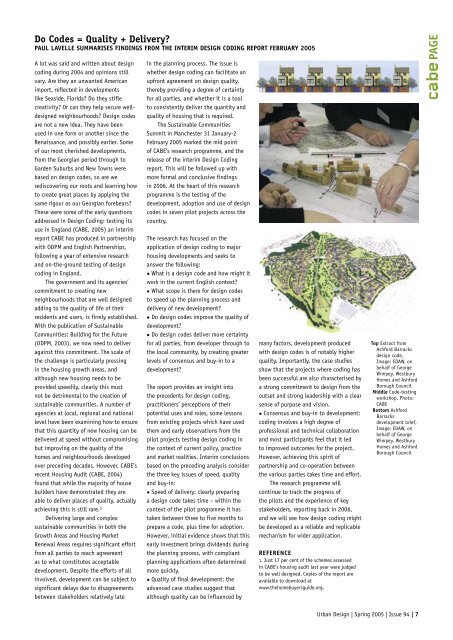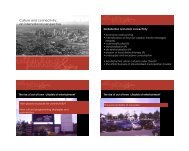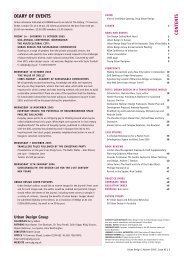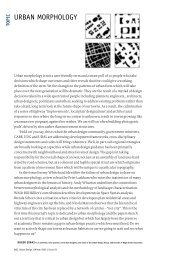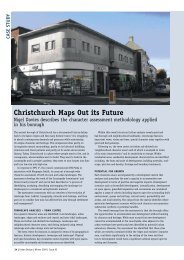CONTENTS DIARY OF EVENTS - The Urban Design Group
CONTENTS DIARY OF EVENTS - The Urban Design Group
CONTENTS DIARY OF EVENTS - The Urban Design Group
Create successful ePaper yourself
Turn your PDF publications into a flip-book with our unique Google optimized e-Paper software.
Do Codes = Quality + Delivery?<br />
PAUL LAVELLE SUMMARISES FINDINGS FROM THE INTERIM DESIGN CODING REPORT FEBRUARY 2005<br />
A lot was said and written about design<br />
coding during 2004 and opinions still<br />
vary. Are they an unwanted American<br />
import, reflected in developments<br />
like Seaside, Florida? Do they stifle<br />
creativity? Or can they help secure welldesigned<br />
neighbourhoods? <strong>Design</strong> codes<br />
are not a new idea. <strong>The</strong>y have been<br />
used in one form or another since the<br />
Renaissance, and possibly earlier. Some<br />
of our most cherished developments,<br />
from the Georgian period through to<br />
Garden Suburbs and New Towns were<br />
based on design codes, so are we<br />
rediscovering our roots and learning how<br />
to create great places by applying the<br />
same rigour as our Georgian forebears?<br />
<strong>The</strong>se were some of the early questions<br />
addressed in <strong>Design</strong> Coding: testing its<br />
use in England (CABE, 2005) an interim<br />
report CABE has produced in partnership<br />
with ODPM and English Partnerships,<br />
following a year of extensive research<br />
and on-the-ground testing of design<br />
coding in England.<br />
<strong>The</strong> government and its agencies’<br />
commitment to creating new<br />
neighbourhoods that are well designed<br />
adding to the quality of life of their<br />
residents and users, is firmly established.<br />
With the publication of Sustainable<br />
Communities: Building for the Future<br />
(ODPM, 2003), we now need to deliver<br />
against this commitment. <strong>The</strong> scale of<br />
the challenge is particularly pressing<br />
in the housing growth areas, and<br />
although new housing needs to be<br />
provided speedily, clearly this must<br />
not be detrimental to the creation of<br />
sustainable communities. A number of<br />
agencies at local, regional and national<br />
level have been examining how to ensure<br />
that this quantity of new housing can be<br />
delivered at speed without compromising<br />
but improving on the quality of the<br />
homes and neighbourhoods developed<br />
over preceding decades. However, CABE’s<br />
recent Housing Audit (CABE, 2004)<br />
found that while the majority of house<br />
builders have demonstrated they are<br />
able to deliver places of quality, actually<br />
achieving this is still rare. 1<br />
Delivering large and complex<br />
sustainable communities in both the<br />
Growth Areas and Housing Market<br />
Renewal Areas requires significant effort<br />
from all parties to reach agreement<br />
as to what constitutes acceptable<br />
development. Despite the efforts of all<br />
involved, development can be subject to<br />
significant delays due to disagreements<br />
between stakeholders relatively late<br />
in the planning process. <strong>The</strong> issue is<br />
whether design coding can facilitate an<br />
upfront agreement on design quality,<br />
thereby providing a degree of certainty<br />
for all parties, and whether it is a tool<br />
to consistently deliver the quantity and<br />
quality of housing that is required.<br />
<strong>The</strong> Sustainable Communities<br />
Summit in Manchester 31 January-2<br />
February 2005 marked the mid point<br />
of CABE’s research programme, and the<br />
release of the interim <strong>Design</strong> Coding<br />
report. This will be followed up with<br />
more formal and conclusive findings<br />
in 2006. At the heart of this research<br />
programme is the testing of the<br />
development, adoption and use of design<br />
codes in seven pilot projects across the<br />
country.<br />
<strong>The</strong> research has focused on the<br />
application of design coding to major<br />
housing developments and seeks to<br />
answer the following:<br />
• What is a design code and how might it<br />
work in the current English context?<br />
• What scope is there for design codes<br />
to speed up the planning process and<br />
delivery of new development?<br />
• Do design codes improve the quality of<br />
development?<br />
• Do design codes deliver more certainty<br />
for all parties, from developer through to<br />
the local community, by creating greater<br />
levels of consensus and buy-in to a<br />
development?<br />
<strong>The</strong> report provides an insight into<br />
the precedents for design coding,<br />
practitioners’ perceptions of their<br />
potential uses and roles, some lessons<br />
from existing projects which have used<br />
them and early observations from the<br />
pilot projects testing design coding in<br />
the context of current policy, practice<br />
and market realities. Interim conclusions<br />
based on the preceding analysis consider<br />
the three key issues of speed, quality<br />
and buy-in:<br />
• Speed of delivery: clearly preparing<br />
a design code takes time – within the<br />
context of the pilot programme it has<br />
taken between three to five months to<br />
prepare a code, plus time for adoption.<br />
However, initial evidence shows that this<br />
early investment brings dividends during<br />
the planning process, with compliant<br />
planning applications often determined<br />
more quickly.<br />
• Quality of final development: the<br />
advanced case studies suggest that<br />
although quality can be influenced by<br />
many factors, development produced<br />
with design codes is of notably higher<br />
quality. Importantly, the case studies<br />
show that the projects where coding has<br />
been successful are also characterised by<br />
a strong commitment to design from the<br />
outset and strong leadership with a clear<br />
sense of purpose and vision.<br />
• Consensus and buy-in to development:<br />
coding involves a high degree of<br />
professional and technical collaboration<br />
and most participants feel that it led<br />
to improved outcomes for the project.<br />
However, achieving this spirit of<br />
partnership and co-operation between<br />
the various parties takes time and effort.<br />
<strong>The</strong> research programme will<br />
continue to track the progress of<br />
the pilots and the experience of key<br />
stakeholders, reporting back in 2006,<br />
and we will see how design coding might<br />
be developed as a reliable and replicable<br />
mechanism for wider application.<br />
REFERENCE<br />
1. Just 17 per cent of the schemes assessed<br />
in CABE’s housing audit last year were judged<br />
to be well designed. Copies of the report are<br />
available to download at<br />
www.thehomebuyersguide.org.<br />
Top Extract from<br />
Ashford Barracks<br />
design code,<br />
Image: EDAW, on<br />
behalf of George<br />
Wimpey, Westbury<br />
Homes and Ashford<br />
Borough Council<br />
Middle Code-testing<br />
workshop, Photo:<br />
CABE<br />
Bottom Ashford<br />
Barracks<br />
development brief,<br />
Image: EDAW, on<br />
behalf of George<br />
Wimpey, Westbury<br />
Homes and Ashford<br />
Borough Council<br />
<strong>Urban</strong> <strong>Design</strong> | Spring 2005 | Issue 94 | 7<br />
PAGE


